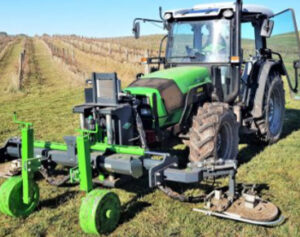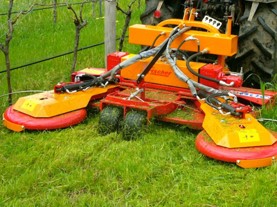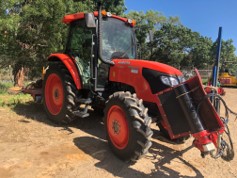Background
Several different tools are used by wine-grape growers across Australia to manage undervine weeds without chemicals. Most growers use a combination of different tools to achieve good weed control.
Undervine mowers (Figures 1 and 2), slasher mowers and more recently, undervine whipper snippers (Figure 3), are used to manage plant growth undervine, whether the plant growth is a sown cover crop, a volunteer sward or weeds.

Figure 1. FMR undervine mower with sensor (image courtesy of FMR)

Figure 2. Fischer undervine mower (image courtesy of Fischer)

Figure 3. Front-mounted undervine whipper snipper and rear mounted undervine mower (image courtesy of Gemtree)
Action
Mowers, slasher mowers and whipper snippers manage weed growth undervine and in the mid-row by cutting or shredding the foliage. Slasher mowers produce coarser material which breaks down more slowly.
Mowing/slashing can be an effective method of managing annual weeds when performed prior to seed set; the timing and frequency of mowing required to achieve good control depends on the weed species and vineyard location.
Advantages and disadvantages
Advantages: Mowing creates very little soil disturbance, which helps to maintain or even improve soil structure and health.
Disadvantages: Mowing provides a short-term reduction in weed competition with vines. Repeated mowing may be required to limit weed competition with vines.
Table 1. Advantages and disadvantages of a mower/whipper snipper
| Ability to reduce weed competition with vines | Average |
| Soil disturbance caused | Low |
| Suitability in young vineyards | Poor |
| Length of weed control | Poor |
| Operating speed | Good |
| Operating cost | Average |
| Capital cost | High |
Considerations
- The timing of mowing operations influences the level of weed control achieved. Mowing crops before they flower and set seed gives the best results. The timing of flowering and seed set depends on the weed species, site and weather conditions.
- The development of autonomous mobile robots and autonomous vineyard tractors will make regular mowing a more feasible option, especially if the vehicles/robots are solar powered and the weight and traffic do not cause compaction.
Table 2. Ease of using a mower on different soil types
| Large or excessive stones | Difficult |
| Stone/gravel | Average |
| Sand | Easy |
| Silt/loam | Easy |
| Clay | Easy |
*Stones must be flush with the ground
Table 3. Ease of using an undervine whipper snipper on different soil types
| Large or excessive stones | Easy |
| Stone/gravel | Easy |
| Sand | Easy |
| Silt/loam | Easy |
| Clay | Easy |
Mowing tips
- Regular mowing may help to reduce weed competition with vines. Alternatively, use of mowing as the main weed control strategy should be limited to vigorous sites.
- Mow annual weeds before they set seed to reduce the build-up of viable weed seeds in the seed bank.
- Use the HerbiGuide website and the AWRI’s Australian vineyard weed profile web pages to determine when to mow weeds in different locations to reduce weed seed set.
- Mid-row swards and cover crops can be mowed/slashed, and side thrown undervine to suppress weed growth. The coarse material from slasher mowers breaks down more slowly to increase its efficacy as an undervine mulch.
Resources
Organic Winegrowers New Zealand. 2017. Undervine weed management – A practical guide to effective weed control in organic vineyards.
Contact
For further information, please contact:
AWRI helpdesk
Phone 08 8313 6600 Email helpdesk@awri.com.au

